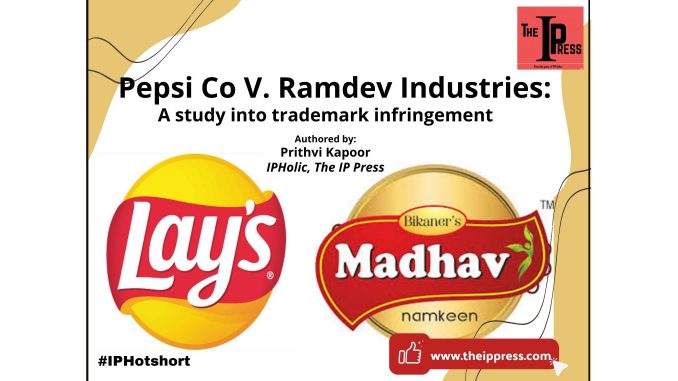
Introduction:
This article is a study of the Delhi High Court’s recent judgment wherein Pepsi Co’s Lays, the plaintiff, was granted ad-interim relief. The Hon’ble Court restrained Madhav Namkeens, an enterprise that produces Indian savory snacks to desist from using a logo that is deceptively similar to that of Lay’s “Sun Banner”. In this article, the author shall aim to explain the reasoning of the court, in light of the concept of deceptive similarity in trademark jurisprudence.
Facts of the Case:
The logo of Lays is essentially a circular yellow globe encircling a bright red banner that reads “Lays” and is familiar to the consumer’s eye. The trademark has received registration under class 29 (which is concerned with meat, fish, poultry, and game; meat extracts; preserved, frozen, dried and cooked fruits and vegetables; jellies, jams, compotes; eggs; milk, cheese, butter, yogurt and other milk products; oils and fats for food). Pepsi became aware of the impugned logo of Madhav Namkeens in August, 2021. The logo which is printed on snacks of Madhav Namkeens bore considerable similarity with that of Pepsi’s registered trademark as it too had a yellow globe inside encircling a red banner with the difference only arising in text wherein it read “Madhav” instead of “Lays”. Pepsi dispatched a cease-and-desist notice to Madhav Namkeens, the latter countering the same by claiming the marks were dissimilar.
Contentions of the Plaintiff:
Pepsi asserted that in furtherance of promoting their device mark of Lays, they have spent around 1.2 billion US dollars from 2008 to 2020. In terms of the Indian market, Pepsi has spent around 855 crores on marketing and promotion of their device mark. Pepsi also asserted that its trademark is a protectable trademark and the same has also been recognized by the Delhi High Court.
Pepsi argued that they had no issue with the use of “Madhav” but only had objections to the logo adopted by Madhav Namkeens, i.e., the sun banner.
Judgment:
The Court held that there indeed existed a prime facie case in favor of the plaintiff, and further opined that when comparing the two logos of Lays and Madhav, there appeared to be deceptive similarity among the marks. It also held that goods such as that of the plaintiff and defendant are those types of goods that are sold in grocery stores, and there could be confusion amongst buyers. Lastly, the court held that the plaintiffs are liable to suffer damages as a result of dilution of its mark by the use of a deceptively similar mark by the defendant.
Concept of Deceptively Similar Trademarks:
The concept of deceptively similar trademarks essentially means when a particular company’s mark is deceptively similar to that of another company, it can mislead people to believe that the former’s mark and the latter company’s marks are one and the same. This is a very common practice by copycats and the same is prohibited by the Trademarks Act, 1999.
In Cadlia Healthcare Ltd v Cadlia Pharmaceuticals, the Supreme Court laid down certain rules which should be followed while determining a suit for deceptive similarity. Some of them include:
- The degree of resemblance between the marks, phonetic or visual, or similarity in the idea
- The nature of goods or services in respect of which they are used as trademarks.
- The nature of the marks, whether the marks are words, labels, or composite marks.
The Delhi High Court in Pepsi v Ramdev Industries has applied this concept and has observed that Madhav Namkeen’s logo is deceptively similar to that of the Lays Logo. The court also remarked that an unwary customer could be deceived by the same.
Prithvi Kapoor
Author
Prithvi is a 3rd year law student. His interests are in Intellectual Property and Data Protection.
Leave a Reply